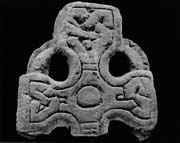Select a site alphabetically from the choices shown in the box below. Alternatively, browse sculptural examples using the Forward/Back buttons.
Chapters for this volume, along with copies of original in-text images, are available here.
Object type: Cross-head [1]
Measurements: H. 30.3 cm (12 in); W. 31.3 cm (12.25 in); D. 15.8 cm (6.25 in)
Stone type: Coarse-grained (with rounded grains), non-calcareous, very pale brown (10YR 8/3) sandstone; deltaic channel sandstone, Middle Jurassic or, more probably, decalcified Middle? Calcereous Grit; see no. 1
Plate numbers in printed volume: 531-535
Corpus volume reference: Vol 3 p. 157
(There may be more views or larger images available for this item. Click on the thumbnail image to view.)
The cross-arms are squared (type A11) with a ring, type 1(a). The ring is stepped with a crest in the Ryedale manner (see Fig. 6).
A (broad): The cross has a flat perimeter moulding. In the centre is an incised circle (not perfect) around which the surface is undecorated. At the neck of the vertical limbs is a transverse flat bar. In the upper arm, above this bar, the surface splits into flat strands forming a Stafford Knot terminal with a pellet in the bifurcation. The lateral arms do not have the bar but do have the bifurcation and the Stafford Knot. The ring is bevelled and rounded in section. It has a stepped crest with incised chevron on the side and no edge moulding.
B (narrow): The end of the lateral arm has a flat perimeter moulding containing a triquetra with a flattened upper loop using a median-incised strand. The top of the wheel's crest is very worn but seems to have had flanking flat mouldings containing a simple twist.
C (broad): As face A, but more worn.
D (narrow): The arm end has a flat perimeter moulding containing the triquetra of face B but turned on its side and containing a pellet filler. The strand is median-incised. The ring rim is also as face B's but damaged.
This is the work of the sculptor who produced Middleton 1. Not only is the stylistic treatment identical, even to the flattened triquetrae, but the manner of cutting, with a preference for bevelled edges, both to the strands and to the ring. It is an example of the eastern Ryedale atelier but also so close to Middleton 1 that we may assume a single hand. All the ring-heads in Ryedale must date to post 920 (Bailey 1978, 178; see Chap. 8).



